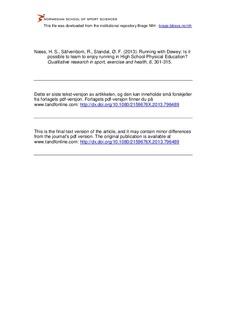| dc.contributor.author | Næss, Harald Solhaug | |
| dc.contributor.author | Säfvenbom, Reidar | |
| dc.contributor.author | Standal, Øyvind Førland | |
| dc.date.accessioned | 2014-09-05T12:24:42Z | |
| dc.date.available | 2014-09-05T12:24:42Z | |
| dc.date.issued | 2013-06-06 | |
| dc.identifier.citation | Qualitative Research in Sport, Exercise and Health. 2013, 6, 301-315 | nb_NO |
| dc.identifier.uri | http://hdl.handle.net/11250/218857 | |
| dc.description | I Brage finner du siste tekst-versjon av artikkelen, og den kan inneholde ubetydelige forskjeller fra forlagets pdf-versjon. Forlagets pdf-versjon finner du på www.tandfonline.com: http://dx.doi.org/10.1080/2159676X.2013.796489 / In Brage you'll find the final text version of the article, and it may contain insignificant differences from the journal's pdf version. The original publication is available at www.tandfonline.com: http://dx.doi.org/10.1080/2159676X.2013.796489 | nb_NO |
| dc.description.abstract | This study is based on an action research project labelled ‘Running with Dewey’ implemented in a second-year High School Physical Education (PE) class. The purpose of the project was to analyse students’ response to a running programme based on experiential learning. Eight students participated in alternative PE for 8 weeks. The action research project facilitated an autonomy supportive and reflection supportive climate, where students were individually given the freedom to choose their own form of running, and reflect on questions concerning the experience of running after each lesson. The data collection consists of participant observation and in-depth interviews. The findings show that many students have experienced running in PE as primarily unenjoyable. The education has to large extent been based on teacher instruction with no possibilities for individual involvement in, choice of, or reflection on the experience. Due to the possibility to choose a form of running they like, the students appreciated the autonomy supportive climate in the project. There are large individual differences in what form of running the different students prefer. The findings indicate that when personal needs guide the form of running, and the students are encouraged to reflect upon their experience, the students experience the running as more enjoyable. | nb_NO |
| dc.language.iso | eng | nb_NO |
| dc.publisher | Taylor & Francis | nb_NO |
| dc.subject | experience | nb_NO |
| dc.subject | physical education | nb_NO |
| dc.subject | running | nb_NO |
| dc.subject | enjoyment | nb_NO |
| dc.subject | autonomy | nb_NO |
| dc.title | Running with Dewey: is it possible to learn to enjoy running in High School Physical Education? | nb_NO |
| dc.type | Journal article | nb_NO |
| dc.type | Peer reviewed | nb_NO |
| dc.subject.nsi | VDP::Social science: 200::Social science in sports: 330 | nb_NO |
| dc.source.journal | Qualitative Research in Sport, Exercise and Health | nb_NO |
| dc.description.localcode | Seksjon for kroppsøving og pedagogikk / Department of Physical Education | nb_NO |
